-
When you click on links to various merchants on this site and make a purchase, this can result in this site earning a commission. Affiliate programs and affiliations include, but are not limited to, the eBay Partner Network.


AHFreak
-
Posts
1,043 -
Joined
-
Last visited
Content Type
Profiles
Forums
NGC Journals
Gallery
Events
Store
Downloads
Posts posted by AHFreak
-
-
I have the most amazing, most incredible solution to all of this HA nonsense....
GREATCOLLECTIONS. COM
I know I know, HA has.....um... er..... well.... what? What is it that they have that make it a better alternative to GC?
GC has incredible customer service, HA has none. GC has extremely quick payout time, HA has... well.... months of waiting to get paid. GC has fees that are reasonable, HA has fees that are so high it is borderline insulting, GC has friendly staff who are happy to make consigning an easy/ simple process. HA has a system where unless one of their agents thinks you have 6 figures worth of coins to sell they don't want to give you the time of day and even when u do have a 6-figure plus consignment it still isn't easy to get anywhere with their "consignment experts" or whatever they ate called. GC seems to treat all their customers the same, whether a 3, 5, 6, or 7-figure consignor. While HA justifies their much higher fees by boasting about their superior buyers pool, meaning they will tell you that even though sellers fees are higher, sellers will net more because there are so many more buyers, GC doesn't say anything and just sells your coins for more money and with less fees as their prices have been and continue to be as strong or stronger than HA for quite sometime now, regardless of the size of their buyers pool....
At this point, i honestly do not know why anybody would work with HA when GreatCollections is available as an option...
All that's just my opinion of course, which isn't very popular around here these days...
Maybe someone could help me out, and give me any reasons how HA can even find consignors of coins when GC is so much better/cheaper/faster at paying out/ friendlier/easier to work with/ etc.... ?
I can't seem to figure it out.
-
Ah, cool stuff. I really like that George III crown.
Interesting that you of all people think these are cool, or like them or whatever. Where are all the haters talking about how these coins are counterfeits and that whoever made them is this or that and should be in prison and all that nonsense?
Are these OK because they are foreign?
Why are these not controversial but DCARR fantasy pieces are? They are essentially the same thing, some poor helpless collector could definately be "taken" by one of these pieces 100 years from now could they not?
Im fascinated by the fact that these pieces would be totally acceptable but DCARR's wouldn't. Why is that?
-
This SH I T is sooooo toxic around here.
Time for a nice long break.
I hope you all enjoy yourselves while bringing other people down, whining, crying and just being overly negative about anyone and anything that doesn't line up with your narrow minded views & opinions.
Good luck
-
What's the surprise announcement? I am pretty well outside of the "in-crowd" and operating in my own little isolated bubble when it comes to the biz for the most part.
I am genuinely curious though if u care to share
Laser slab engraving that confirms that the CAC sticker is accurate in calling the coin accurately graded as an A or B coin for that slab grade.
Question is, when will see an exanpsion of the archaic ABC rating system. There are so many more letters that can better express where the coin falls on the quality spectrum.
Tell me you're joking... ? Is this something CAC would do, PCGS/NGC, or are we going to be blessed by the graces of yet another pay to play must have for slabs? This has to be a joke... ?
-
What's the surprise announcement? I am pretty well outside of the "in-crowd" and operating in my own little isolated bubble when it comes to the biz for the most part.
I am genuinely curious though if u care to share
-
I have read the last few days of posts in this thread with great interest. Wondercoin has been asked several times now about the 'marks' on the torch.With great eloquence of prose, wondercoin has steered around, misdirected, or simply avoided requests for him to comment on the marks on the torch. Yet this whole thread, is about the marks of the torch and whether that warrants the grade provided by the TPG which sets a market value for the coin. Very entertaining stuff!

Best, HT
That sounds harsh and unfair to me.
His post which preceded yours, reads, in part:
"That said, when I look at the dime again more closely in the next month, I will pay closer attention to the one focal area that seems to be the focus of this discussion. And, I have already said that I would be happy to discuss my findings with anyone seriously interested in the coin in good faith. Nothing more I can do."
And in another post the wrote:
",...I made it clear that once I have the coin in my hands again (having seen it for a couple minutes over the past few years at this point) I will be happy to carefully look at the reverse of the coin again and speak to anyone interested in purchasing the coin as well. My email was provided above."
There might be others, too, but I think the above two quotes make my point.
Mark,
Neither of these two quotes specifically address the questions posed for the marks. What is unfair? Anyone looking at the pictures on ebay can clearly see them, the dealer doesn't have to retrieve it to see the marks.
Best, HT
So wait, you are asking him to comment on the hits... and he is saying he will as soon as he gets the coin in hand and can view it again in hand. But yet you are accusing him of avoiding, or dancing around, etc? That makes no sense at all to me. If he did adress the hits without the coin in hand wouldn't that be even more of a reason for you and others to take issue with it? Seems to me that NOT having the coin in hand before addressing the marks would be the main reason to call him out.
What are you expecting, what would you like him to do above and beyond what he has already done?
-
"....but based on the original coin, if it is a MS68 FB by PCGS color standards, then I see no reason the 1950 wouldn't be."
If this is true, color (eye appeal) plays a powerful role in the grading process – overriding even original condition. Pretty interesting, for something that is produced post mint.
Eye appeal is the most important factor in grading a coin, that's one of the first things you learn in the grading classes.
Also, I hate to be the guy who does this again in this thread, but the nose and chin on that 1950 dime do not have hits on them, not saying that they should or shouldn't affect grade, I'm just saying they were caused during the minting process... if that affected grade, then we would need to acknowledge any and all machine doubling and factor it into the overall grade of the coin. I'd rather not go there after this thread
-
If I remember right, the 1964 MS68 Kennedy half dollar fetched 25K at auction in Feb.
-
Interesting, so are the marks on the torch for the Roosevelt dime we are discussing tumbling marks? Is there flow lines that one can observe? Do such flow lines show up on devices? If not tumbling marks if there is an absence of flow lines, then what would be the origin of these marks?
Best, HT
This is IMO the reason this photo became such a heated discussion because in a photo these marks look beyond ugly/distracting/ annoying/etc...they look similar to true dings/hits/post mint marks.... I get that.
What I've been trying to explain is that they look no where near as dramatic or noticeable under light, when rolling and tilting the coin during a grading process.. reason for that is because the luster flows through them, and cruises right over top of them opposed to actual hits where luster actually highlights and points out said flaws (that is why we roll and tilt under light in the first place). To find flaws. These types of marks are virtually unnoticeable under light, unless u r looking for and trying to find them.
-
Yes there are flow lines on devices. Not sure about anyone else but I need a loupe to see flow lines. Luster is another thing alltogether. That's where the difference is on pre mint marks versus post mint marks. The luster seems to cover up/flow right through pre mint marks. (Because of flow lines). Post mint marks are distracting, they jump out at you when viewing said coin under light, they take away from luster because luster goes around it marks, is broken because of the marks versus flowing through them effortlessly and in a sense, (when grading under light) covers them up/minimizes them in a way.
That is an artsy way of explaining that, but hopefully I don't get ringed for that, and readers can allow there minds eye to follow what I'm saying.
-
So Mark, are you speaking in generalities when u talk about mint made flaws/ distractions? or are you referring specifically to the dime that started this thread? I am curious as to your opinion on the 2 marks on the bottom torch of the dimes , are those 2 marks a product of the minting process or mint-made flaws/distractions OR are those 2 marks literal "hits/scrapes/dings/etc.." or other post mint damage so to speak?
The other question Mark, In your opinion should these marks be factored into the grade a particular coin is given?
I am surprised at how divided the opinions are on what the marks actually are and how they should be factored into the grading process, mainly because almost every single coin I look at/buy/sale/submit for grading/etc have those marks to some degree from copper cents to dollars and everything in between.
-
They are definately not strike throughs coinman , Although in terms of how they are seen in hand, they are much more comparable to strike throughs then they are to hits/dings/scrapes/etc...
Instead of everyone being so quick to right me and my remarks as I'm some blind insufficiently_thoughtful_person, can we try to put our minds together and figure out what they really are? Cause I'm 100% sure the marks in the dime and all the coins I posted pictures of are not anything along the lines of hits/drops/ scrapes/ gouges/ dings/ etc.
everyone picture for a second a coin that has 10 small and minor struck through small bits of thread on the obverse of the coin... this is very common on 1965-1967 SMS Kennedys, and to have a coin with 10+ small struck through threads is not hard to find. I see them frequently. Take that coin with 10 of those, and imagine 2 scratches/ bag marks/ dings/ etc in said coin... now imagine the coin is under light, rotating, like how u do when grading a coin... well those struck throughs will look nothing like the scratches because of how the scratches reflect the light, struck throughs do not reflect light they absorb it. That is how u find issues on coins is by hitting it at the right angle so the light illuminates them and therefore pointing them out. Agreed?
The struck throughs, while being very obvious in a photo are no where near as obvious when said coin is in hand being rotated under light. Think about that for a second. Think about why that is..
Now, if I haven't lost you yet, and if u care enough to be reading still, picture these anomalies we have been talking about behaving exactly how struck throughs behave...(while rotated under light). That's how these minor anomalies are, very obvious in a photo, appearing almost exactly like hits/dings... but in hand, very nondistracting and majority of the time completely unnoticeable at all. (Obviously the ones on the dime are relatively extreme). But still in hand, They look nothing like hits and dings. They look more like what a struck through would look like.
I'd be curious to know what causes it, if someone like RWB, or PF3.14 could allow themselves to understand what I'm actually saying before telling me to check my eyes, my head, or my understanding of simple science and how it relates to the minting process, I am confident one of you brilliant bastards could humor all of us by figuring out what causes them. Im quote certain it has nothing to do with the planchet.
One other thing, for all of you convinced these are all scratches/ dings/ hits/ etc.... think about what happens to the surface of the coin when something hito it hard enough to leave a mark... the metal is simply moved, displaced... it's never just gone or removed in any scenario in which hits/ dings happen to coins. Go look at a traditional bag mark, u will notice that next to where the metal is "dented" in, it is also raised.. this is the case on every single scenario where coins have dings/ bag marks/ scratches/ hits... the metal is displaced not evaporated... now go look at the coins I popted pictureso of... those are literally craters and gouges where there is no metal... WHERE DID ALL THAT METAL GO if these were traditional hits/ dings as so many of you are insisting? They flat out are not hits/ dings...
Regardless of whether or not coins with these anomalies should be graded the same as coins without them is irrelevant to me, I couldn't care less about that. Although I don't think they take away or detract from a coin grade wise ever, and I doubt any of you would be to worried about the markings had you first viewed the coin in hand instead of in pics. .
I am hoping that some of you who have commented about why you are right and I am wrong will get out of your own head long enough to read this post of mine and actually think about what I just threw out there, mainly, where did all that missing metal go when these coins were dropped/ dinged/scratched/ bruised/abused/molested/bagged up or whatever it was that caused these markings that you are insisting is literal damage.... ?
PF3.14, I'm still waiting for you to figure out and share with me what kind of force it would take for two dimes colliding to cause the gouges on the reverse torch of the ms68 1964 dime we are talking about here? If it wasn't caused by two dimes colliding, think of the other possible ways damage happens to a UNC MS coin and again, figure out the force required to cause a situation like what's on the reverse torch... dont go disappearing on me now.. im genuinely asking for your scientifically derived thought process to answer that.
-
These "nicks and dings" are more common on PROOF Franklins than b.s. how do you suppose those nicks and dings got on these proofs? Keep in mind we are talking 1950 and 1951 proofs, handled one at a time, by hand, never coming into contact with anything other than human hands and cellophone before being tucked into a proof set box?
Coins can acquire hits through cellophane. Browse eBay and you will see no shortage of early proof sets with the cello folded over and stapled together, allowing ample opportunity for the coins to clang together.
Nevertheless, your entire argument is predicated upon a striking anomaly. How is it that the metal never completely filled the die and yet (1) it was not the lowest point in the die and (2) we have a very strong strike (on the dime)?
Robec mentions a strike through, but there are even breaks in what I have labeled as a hit in the bottom. It would seem very unlikely to have that many strike throughs on one coin. More importantly, how could one make a principled distinction that could be consistently applied in grading these (i.e. strike throughs that look like this v. hit)?
Edited to add: I find it interesting that you chose the Franklin Half Dollar as one of the representative series to make your point - the series is notorious for grade inflation.
The following are the minimum standards for eye appeal on high grades: MS/PR68 – Must have positive eye appeal MS/PR67 – Must have above average eye appeal MS/PR66 – Cannot have below average eye appeal MS/PR65 – Cannot have negative eye appeal. AMS/PR65 coin can have below average luster or color (toning) if it is outstanding in every other way.
The hits, gouges, "voids," or {insert preferred term here} seem to detract from the eye appeal; at least the PVC colored stuff accents the brown toning reasonably well.
I find it interesting that PCGS has a code for putting coins with mint made planchet flaws in genuine holders. Those coins are as struck. Why should putative striking abnormalities be treated differently? It would seem that in market grading (which PCGS does), everything matters.
Hey Coinman,
Every coin (95% of them anyway) from the era, Im talking cents through halves have it. Business strikes and proofs....... It is merely a coindidence that most my pics were PCGS... go look at only NGC pics and the coins from the years will have the exact same markings... They are not mint made planchet flaws..IMO they do not even have anything to do with the planchet being flawed and a more likely answer is that the coins have a high enough relief that when struck the metal doesn't entirely fill the device, so you get areas where the metal comes together in a way to cause these little anomalies. , meaning little creases or voids like this happen.
What everyone is failing to realize, is that we view, and grade coins while rolling them under light.... hits/scrapes/scratches/etc will reflect the light, shooting light back at the viewer saying, look at me, I am a bag mark or whatever... these absorb the light because it isn't a scratch, there is no raised metal, meaning under light they are not even noticeable unless u r looking for them... photographs show them in a way that viewing under light does not.
Also coinman... Your thought about the proof getting contact marks through cello.... no duh... of course a coin "could" get marked up through paper thin cello... But go figure out how a 1950 proof would get that marked up, and still make it into a PF67 holder... (NGC graded)... Then go look at every other 1950 proof in a 66 or 67 holder and notice they all have the same thing... Are they all marked up? I think not myfriend.
-
Getting back to some factual data about this coin, it was lot 763 in the JHF 1/4/09 Superior auction. It did not sell (e.g. it didn't make it's reserve).
I do NOT know which are the more factual pictures, but there is a lot more visible color on the eBay pix than on the catalogue pix.
EDITED TO ADD: The pix 2 posts above were added while I was adding the above post.
I've only been grading Franklins for 25+ years now, so I guess I just don't know how to do it. Those are nicks and dings. By definition a coin CAN have them up through a 69 grade.
These "nicks and dings" are more common on PROOF Franklins than b.s. how do you suppose those nicks and dings got on these proofs? Keep in mind we are talking 1950 and 1951 proofs, handled one at a time, by hand, never coming into contact with anything other than human hands and cellophone before being tucked into a proof set box?
-
And there is a big crack on the bell
mark
Shoot... I thought that crack was just on the holder.. Let me go find one that's not cracked
BRB
-
OK, First of all, I took these photos directly from HA's site, completed auctions.
First pictures are of a 1950 Proof Franklin. NGC graded PF67. Can we all agree if there were scrapes and bag marks all over the coin, that they wouldn't give it a 67? I agree, and I grade them... regularly. so if you don't agree, try looking at a few, then grade some;)
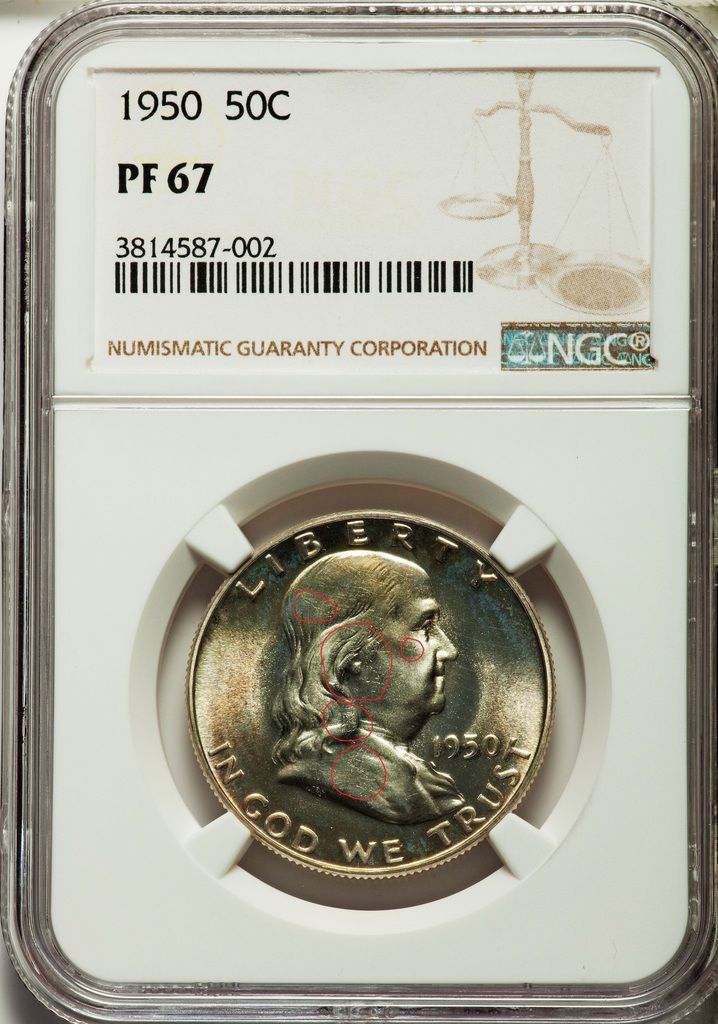
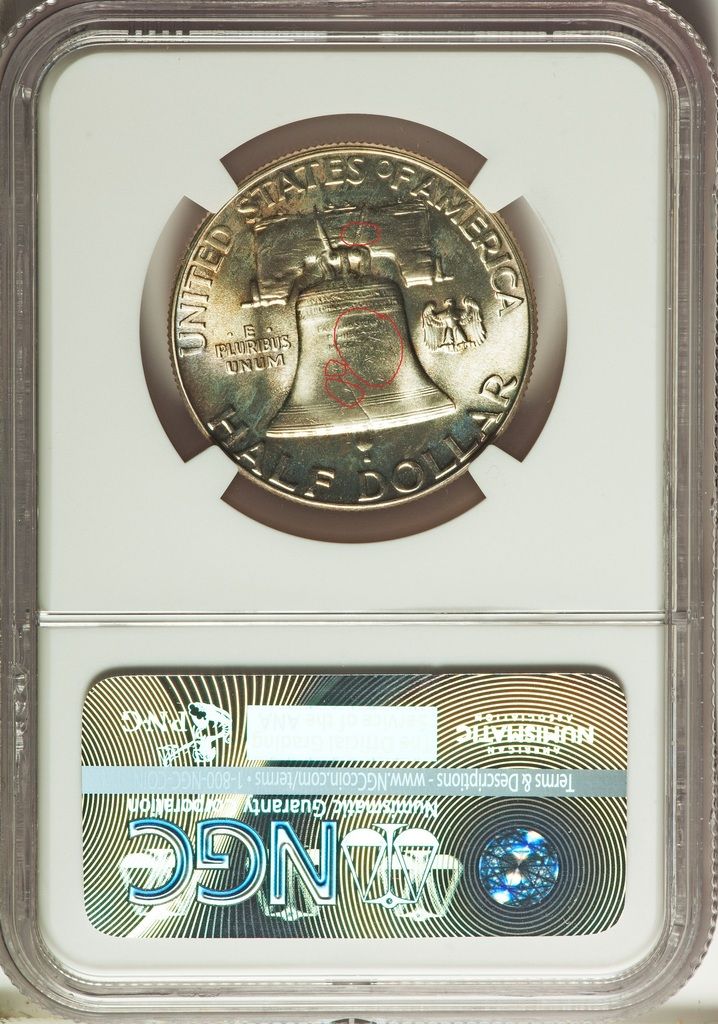
Now we have a business strike 1950 Franklin, MS67 is the grade.
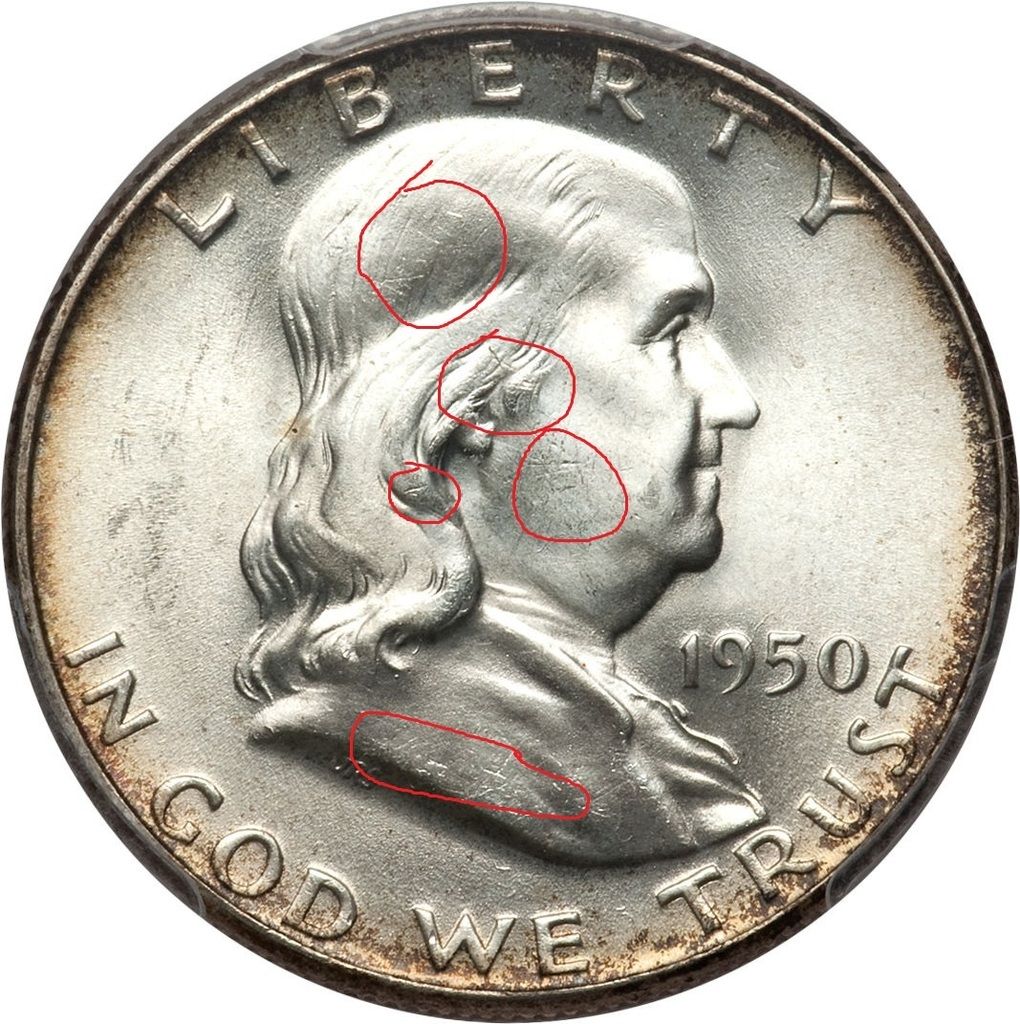
Here are some Kennedys all MS67's
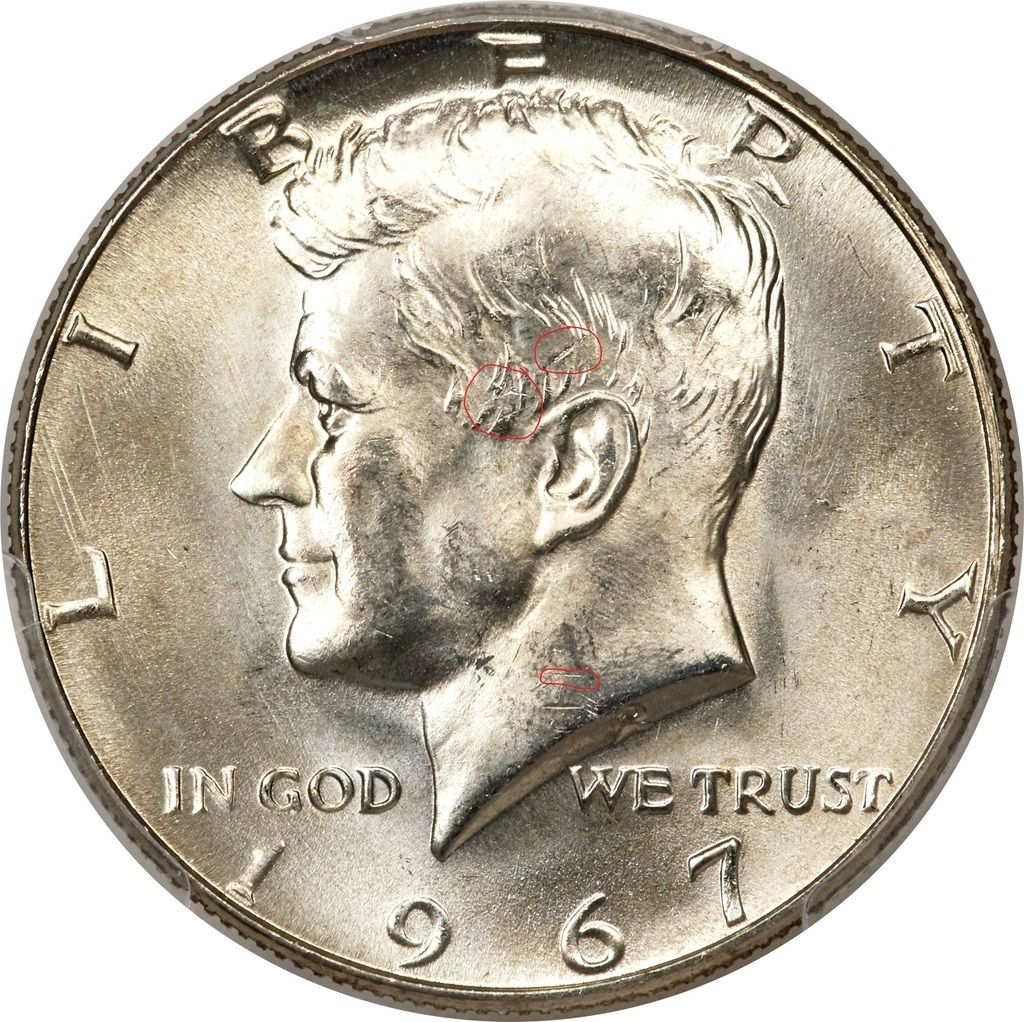
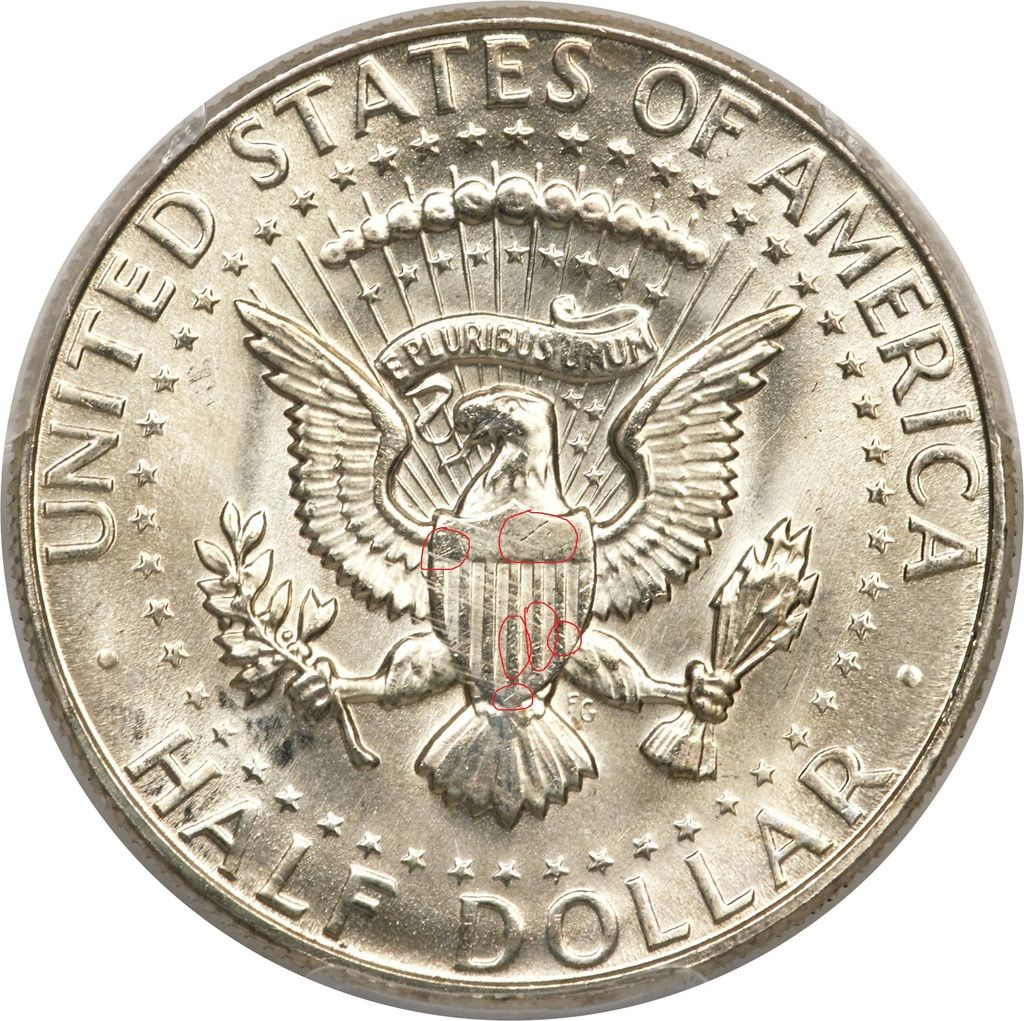
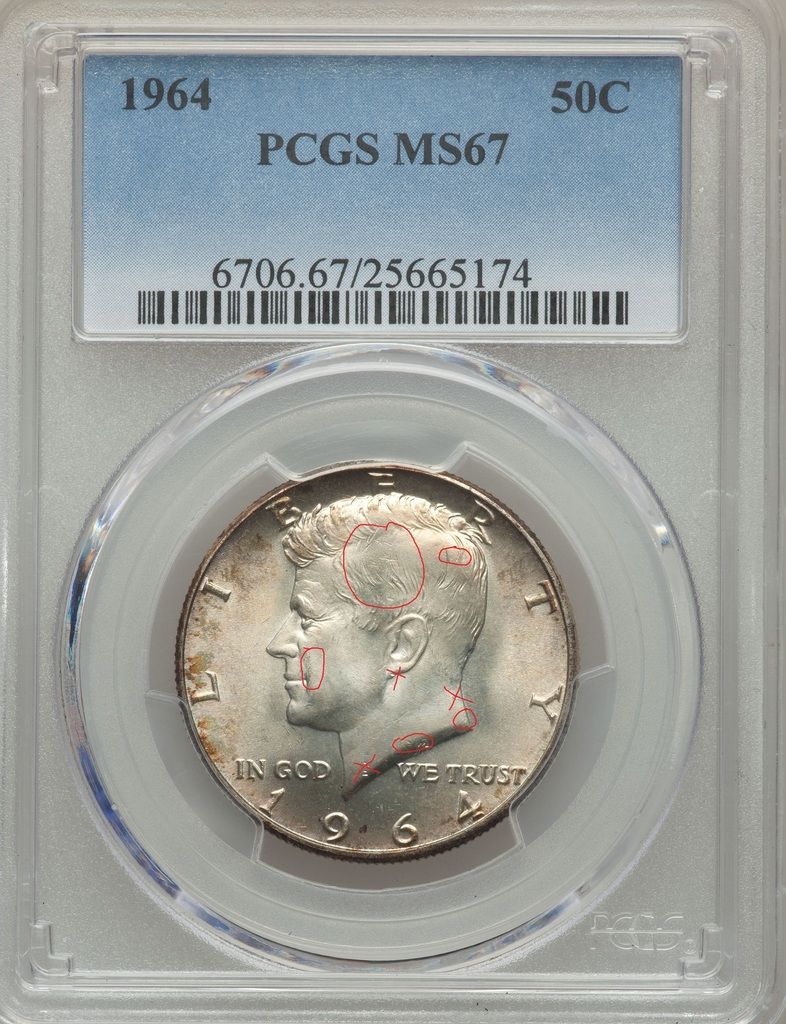
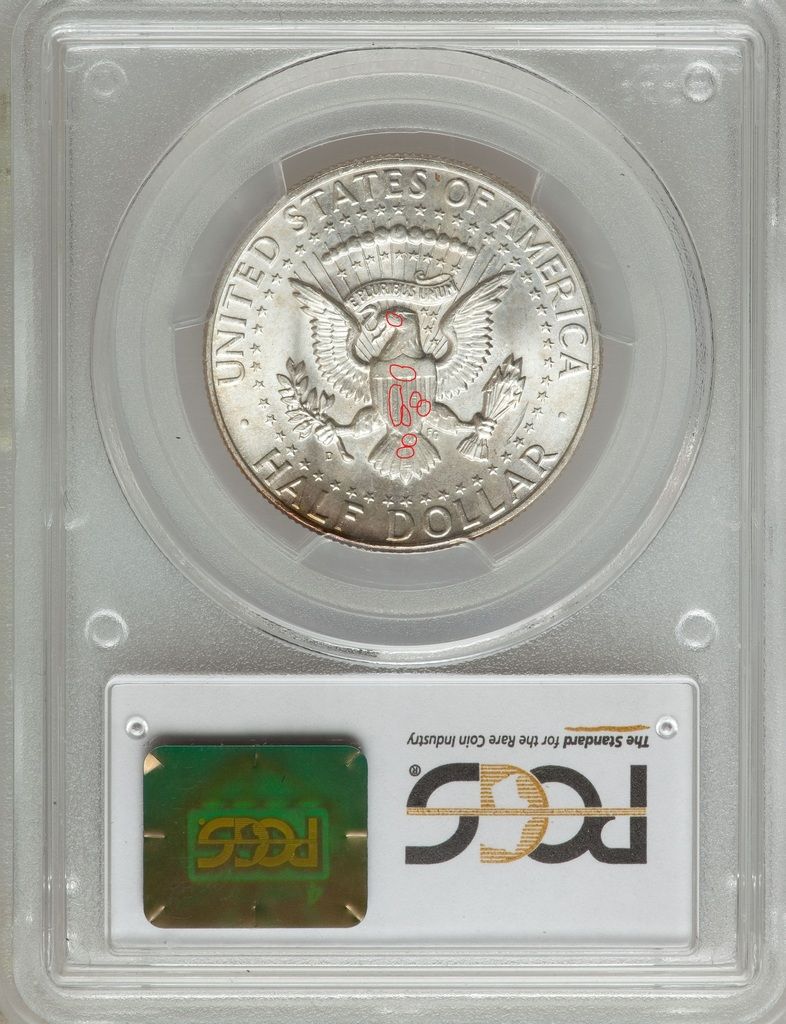
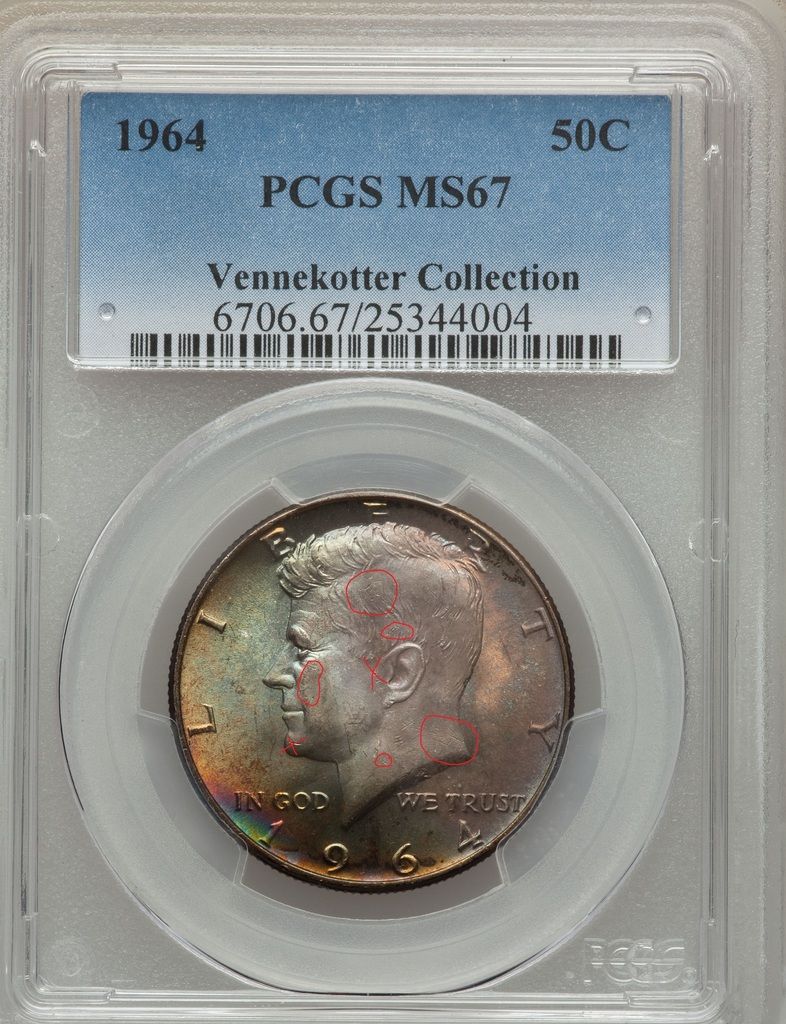
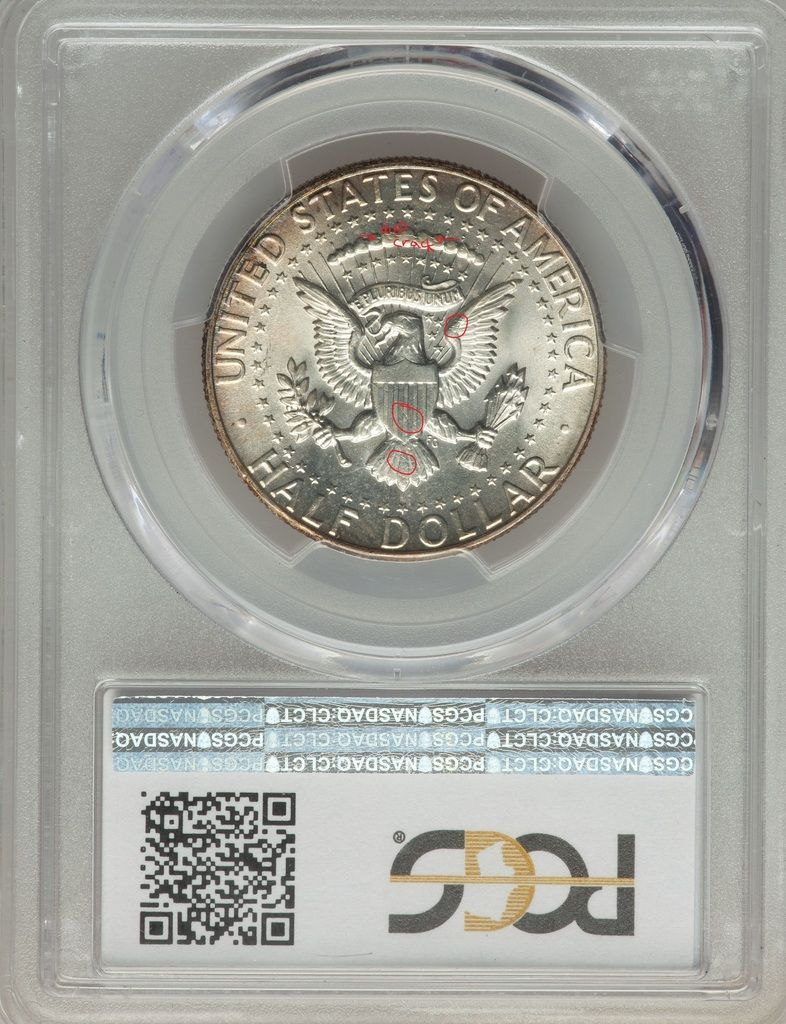
The exact same markings are on dimes, quarters, and halves from the same period... Not sure what they are, not sure I need to know the scientific extent of what they are.... I just know they are not hits/scrapes/dings/etc... The same exact way I know the two markings on the lower portion of the torch are not hits/scrapes/dings/abrasions/etc..
Before the next person calls me out, go look at some silver coins from the 50's and 60's and then lets chat;)
-
Im about to post them.. I will need someone to handle that MUMU. I can look at and discuss coins, but red arrows on photos are waaayyyyy above my range of abilities.
-
If the two marks labeled with red arrows are incuse, then the only way to make them during manufacture is by having corresponding raised features on the die. If the features are on the die, then thousands might have been made with identical marks (but no red arrows...).
I literally have countless coins that prove otherwise. Again, Im not talking bagged up b.s. strike KEnnedys (aren't they all bagged up anyways?)... I am talking about proofs, again, markings like this are extremely extremely common on early proof Franklins, I am going to try to post a picture of a 1950 PF66+.... they have the same/similar markings on both the obverse and reverse devices.... everyone here should be able to agree they although they look similar, they are not hits/scrapes/or bag marks... otherwise, they wouldn't be on a proof coin graded PF66+ (currently in a ngc holder but was in a PCGS holder before that, graded PR66+. I did not cross it, I cracked it and sent it raw, meaning that both NGC and PCGS graded the coin a 66+ this year. absolutely wouldn't happen on a proof with bag marks/scrapes/hits/etc..
Roger, Im glad you chimed in, tell me what you think after you see the pic I will post shortly.
-
Ok lets just pretend for one second they are hits/scrapes.... Can someone please just for a second tell me what kind of force it would take for ANOTHER DIME coming in contact with the coin in question to literally remove metal and leave gouges like that? Gouges that are thicker than the width of any dime ever made? I'm just curious what you guys think it would take for contact with other dimes to gouge metal like that, as far as the physics of it.? Maybe u could answer that PH3.14?
I might be the only I'd iot who looks at mainly 1950-1970 coins literallt all day long, every day for my living.... hopefully for everyone who isn't understanding what I'm saying, someone with a little more credibility around here will chime in and explain what those are, because all I know is they areally not hits/scrapes/etc... period end. In a photo they look 10 times more noticeable than they are in hand. IMO, it's because under light. Especially when grading a coin, they are hardly even noticeable. Opposed to bag marks/ hits/scrapes/ abrasions where when viewed under light they jump right out at you as the light reflects off said marks. These are nothing like that.
For anyone who truly is convinced otherwise, how many 50-60 Era coins are you looking at under light and submitting for grading everyday?
-
Maybe what you are missing is that those "hits/scrapes" you are talking about most definately are not hits or scrapes on the torch. Most coins that I've looked at from the same period have them. They are voids from where the metal didn't fill in the die completely when coin was minted. Had you been looking at the coin in hand, under light, you probably wouldn't have noticed them, but even if u did you would have known right away that they weren't "hits/scrapes". I don't know if any 1964 Kennedy halves exist without those same characteristics to some degree. They are also very commonly found on Franklin halves and especially early Franklin proofs. (50-51 mainly) although common on 53 & later.
They are clearly post-strike abrasions/hits. Either we're looking at different coins, or you need to get your eyes checked.
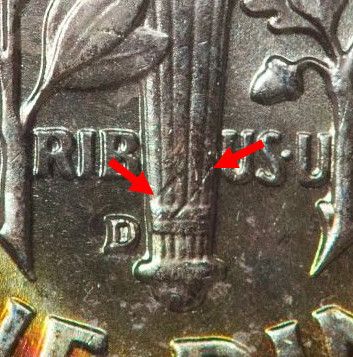
Thank you thats absolutely incorrect. Thanks for your pretty red arrows though.... those were exactly what I was talking about NOT BEING HITS, and they still arent.... I'll check my eyes if you go look at some coins... clearly you could use some experience.
AHFreak, the red arrows were there the first time I posted that picture on PAGE 2 of this thread. If you would have read the whole thread, you would know that.
As for them somehow being pre-strike planchet anomalies, you are simply wrong. As physics-fan has pointed out in his post above this one, that guess fails the logic test for how coins are actually struck between dies.

I never said they were pre-strike anomalies. They are not. Nor do they have anything to do with planchet roughness. I have no interest in getting into a technical conversation about the minting process. It makes no difference to me what they are, I'm simply pointing out that they are not hits, or scrapes, or bag marks. In other words it's not contact or damage. It came right out of the dies just like that. I have countless Franklins and pre1970 Kennedys that are bothe UNC and Proof with the exact same markings, and I'm not talking about bunch of bagged up raw coins. Im talking MS66 and better business strikes, and PR67 and better proofs. NGC and PCGS graded. PF3.14 I appreciate your thought out logic, but I can assure you they come on other areas of the devices... not just the "high points"... I couldn't care less if anyone believes me or not, what the red arrows point to on this ms68 dime simply are not hits.
-
Maybe what you are missing is that those "hits/scrapes" you are talking about most definately are not hits or scrapes on the torch. Most coins that I've looked at from the same period have them. They are voids from where the metal didn't fill in the die completely when coin was minted. Had you been looking at the coin in hand, under light, you probably wouldn't have noticed them, but even if u did you would have known right away that they weren't "hits/scrapes". I don't know if any 1964 Kennedy halves exist without those same characteristics to some degree. They are also very commonly found on Franklin halves and especially early Franklin proofs. (50-51 mainly) although common on 53 & later.
They are clearly post-strike abrasions/hits. Either we're looking at different coins, or you need to get your eyes checked.

Thank you thats absolutely incorrect. Thanks for your pretty red arrows though.... those were exactly what I was talking about NOT BEING HITS, and they still arent.... I'll check my eyes if you go look at some coins... clearly you could use some experience.
-
Now, I am convinced that I am missing something. What am I missing? Am I really this oblivious to the series? The hits on the reverse would preclude anything above a 65 for me.Offered here is THE nicest 1964-D Roosevelt Dime ever graded at PCGS in their near 30 year existence as the TOP grading service!! A pop 1/0 coin...!
The state of preservation of this dime (especially the obverse) is utterly amazing. Bear in mind, this coin was graded PCGS-MS68FB a long time ago and any suggestion of "recent gradeflation" simply does not apply to this coin that has been in this holder for a long, long time!! ...
I am on PCGS' prestigious "Board of Experts" having been hand picked as PCGS' top (outside) modern coin expert at the time.
Maybe what you are missing is that those "hits/scrapes" you are talking about most definately are not hits or scrapes on the torch. Most coins that I've looked at from the same period have them. They are voids from where the metal didn't fill in the die completely when coin was minted. Had you been looking at the coin in hand, under light, you probably wouldn't have noticed them, but even if u did you would have known right away that they weren't "hits/scrapes". I don't know if any 1964 Kennedy halves exist without those same characteristics to some degree. They are also very commonly found on Franklin halves and especially early Franklin proofs. (50-51 mainly) although common on 53 & later.
-
How can a strike look au53?
Like this? I've heard the coins in the OGH aka "Rattlers" were graded more stringently.
More often than not, I find that to be the case.
Exhibit #1:
Exhibit #2:
So you are assigning a grade to the singular element of strike, which happens to coincide with the 70 scale used to do determine overall grade based mostly on wear, of which strike is a singular of many elements of? Is that correct?
I am just pointing out that while that may work for you own selection of coin, and there would be nothing wrong with that as I too value strike heavily in liking a coin, it has very little real world impact on grade, and as in the case of with the owner of the most expensive coin ever sold "the strike doesn't matter one bit".
Not to mention the fact that neither of those two AU coins, nor the MS64 coin's assigned grade had anything to do with strike.... that first one is a great looking, weakly struck MS coin, which is why it is limited at 64. Those other two were coins that had been slightly circulated... if you can't see that, I would practice up on your grading skills.
-
Wow that is cool info though... thanks


Are Heritage auctions real?
in US, World, and Ancient Coins
Posted
How so?
And yes HardTimes, I did forget to add the incredible speed at which you recieve win items... today was Wednesday, so i recieved my box of coins from GC that I won last Sunday... yes the coins I won Sunday night, arrive no later than 3 days later... it has never taken longer to get my coins, as long as I've paid Sunday night or early enough Monday morning.
RWB, I'm guessing you are talking about the material HA has versus GC... if so, I'm extremely confident we are seeing that start to change. There will come a day, sooner than later when GC is preferred over HA. Both by buyers and sellers. There really is no comparison between the two. Gc is easy and great to work with, HA is very hard to work with (when they aren't being impossible to work with)..so far for me, they have made it impossible for me to work with them.
If not there slready, GC is well on their way to surpassing anything HA has to offer for buyers and sellers.